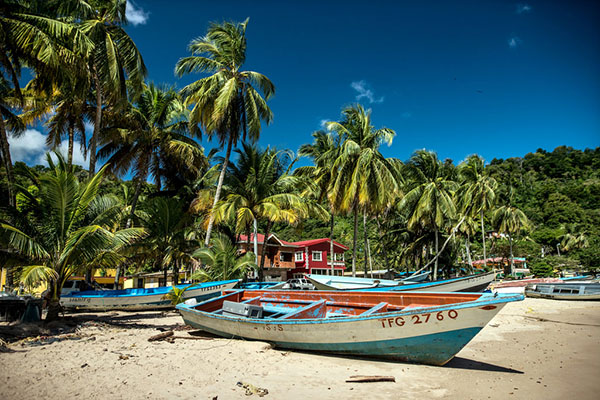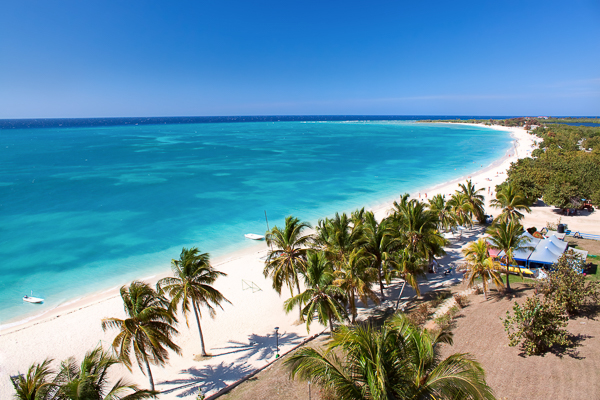Story by Chrystal Young / January 26, 2018


Carriacou is part of the tri-island state of Grenada, Carriacou & Petite Martinique in the Windward Islands. With its unspoiled beaches, lack of major development and friendly locals, it’s the real Caribbean. It’s also home to an active traditional boat-building community.
Craftsmanship in general is a dying art. Most kids are more interested in their electronic gadgets than crafting a boat out of woods. Wood? Who even uses wood anymore to build a boat? Yet, the majesty of a classic wooden cargo sloop or schooner sitting quietly at anchor in an idyllic palm-tree-lined bay is the stuff dreams are made of.
Oh, not just any wood, but exotic woods with names such as greenheart. West Indian white cedar and silver-balli. These are woods with a purpose. You need just the right shape, just the right curves and just the right density for the carious parts of the boatbuilding process to earn the right to be an authentic Carriacou boat.
Knees, frames, keels, decks and planks are the language of the shipwright. Each stage is precise and orchestrated. You can’t skip a step because of deadlines. The boat is done when it’s done and you would never ask “Are we there yet?” to a master shipwright. (Well, you could – but it might take even longer!)
So, where did the builders learn their craft? How can an island isolated in the southern end of the Eastern Caribbean island chain have such a rich history of boat building? During the 18th century, Scottish settlers gathered near the northern end of the island, establishing the village of Windward. “Dem” say the Scots were brought by the plantation owners to build boats for inter-island commerce, or as indentured servants after slavery was abolished, or as part of the Scottish policy of sending “unwanted elements” to the West Indies. The beginnings don’t matter as much s the rich reward of master boatbuilding on this tiny island. Just east of Windward you will find a graveyard washing away into the sea. The grave makers have names suck as McLawrence, McCloud, MacIntosh, McLaren, McFarlane, McKensie and McQuilkin, which are testament to the Scottish heritage of Carriacou.
Open double-enders, decked sloops and schooners are all popular models of Carriacou boats. Some have distinguishing characteristics specific to the Carriacou builders. For instance, the Carriacou schooners have an extended overhang on the stern. This adds to the sleek line and unique look of such boats as Jamabalya, built by Alwyn Enoe. The movie “Vanishing Sail” chronicles his three-year journey building Exodus, thought by some to be one of the last Carriacou sloops.
For transporting goods between the islands in the days of sail, the Carriacou sloop was the fastest and most beautiful of all the workboats. The run up the island chain would include cargo suck as limes, cotton and sugar. The sail back down would often include items such as liquor and cigarettes that were landed without benefit of Customs clearance.
Now, these boats can mostly be found in the charter trade or racing in classic regattas. With the charter option, you have the opportunity to sail on one of these beauties without the obligations that go with boat ownership. Or you can try before you buy if you’re in the market for a classic yacht. You can find these boats under full, glorious sail at the Antigua Classic Yacht Regatta and West Indies Regatta.
If you are planning on going through the Antigua Classic Yacht Regatta (April 19th through 25th), look for the Carriacou schooner Jambalaya. It is one of the last schooners built by Alwyn Enoe, in 2002, and the only Carriacou schooner built as a passenger vessel. You might also look for the newest Carriacou sloop, Free in St. Barths, built in 2015. She won last year’s West Indies Regatta, followed, in third place, by another Enoe sloop, Genesis. Another well-known Windward boat is Mermaid of Carriacou Built in the 1960s by Zepherin McLauren, she dominated the winner’s circle for over a decade in the early days of the Carriacou Regatta and is still sailed by her long-time owner, John Smith, now in the Western Caribbean.
Some “old heads” say the boats from Anguilla are the strongest but Carriacou-built boats are definitely the prettiest. “Dem” say the boars hand-built in Carriacou are built with a soul. Watch one sail across the sunset and you will agree!
We had an outstanding experience working with Andrew Hodgdon. From the very beginning, he demonstrated deep knowledge of the catamaran we were considering and took the time to understand exactly what we were looking for. He found us the perfect vessel that matched our needs and budget and negotiated a fantastic deal on our behalf.
What truly set him apart was he responsiveness—every question we had was answered promptly and thoroughly, and he guided us through the entire process with professionalism and care. We couldn’t be happier with the service and highly recommend him to anyone looking for a knowledgeable and dedicated yacht broker.
Awesome company that worked as my brokerage on purchasing out FP catamaran. A special shoutout to Will Miller for walking us through the process
The process of selling our boat was made very smooth by the Multihull Company and Andrew Hodgdon in particular. Andrew helped us navigate the selling process including moving our boat from Grenada to Florida to execute the sale. We would recommend working with this company, and Andrew Hodgdon in particular, without hesitation.
Very smooth process. Chuck was great and very knowledgeable about the whole process. Im happy to have had TMC to take care of all the things i didnt know about.
Andy
We feel like we got tremendous service from Chuck. He is a total professional, knowledgeable, confident and a natural salesman. While I’m really sad to give up the boat, we are compl we are completely satisfied that Chuck sold it for us.
Successful relationships cannot exist without it. At The Multihull Company we base every relationship on a firm commitment to earning and retaining our client’s trust.
Advice of any kind is valuable only when grounded in hard-won expertise. It too, must be trustworthy. Trust and expertise define the heart and soul of The Multihull Company. We are a team of skilled professionals who thrive on providing expert, trustworthy advice and service to catamaran and trimaran sailors around the globe.
Read More